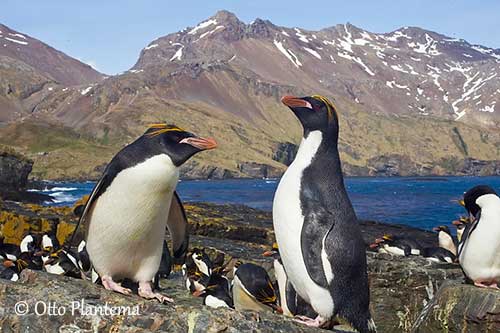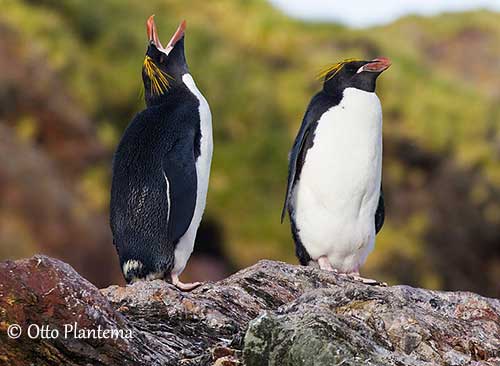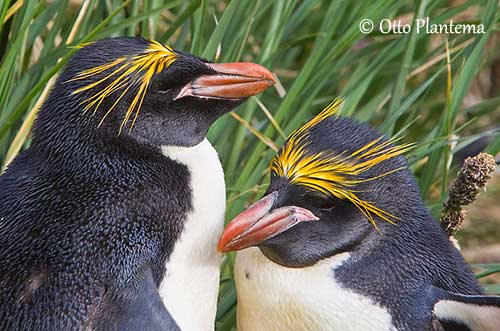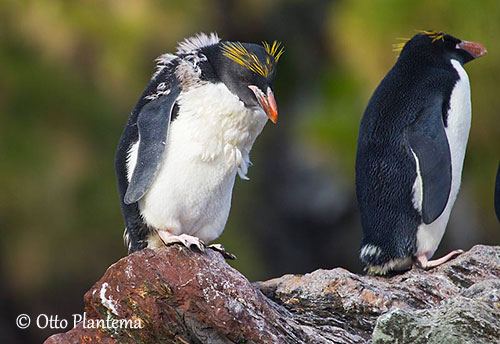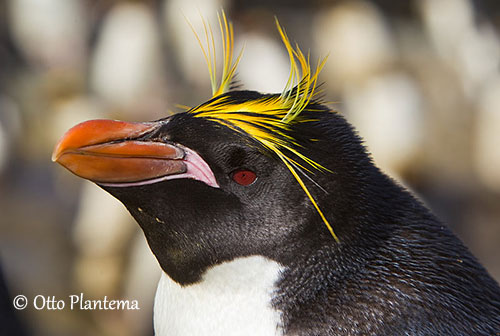
Macaroni Penguin
Eudyptes chrysolophus
Sphenisciforme Order – Spheniscidae Family
BIOMETRICS:
Length : 70-71 cm
Weight : 5-6 kg
DESCRIPTION:
Macaroni Penguin’s name comes from the yellow crest. The term “Maccaroni” was used for excessive ornamentation on Dandy’s hats in London, in 18th century.
Adult male has black plumage on head, upperparts, upper flippers and tail.
The underparts are white.
On the black head, we can see conspicuous sparse orange-yellow long feathers on the forehead, mixed with some black feathers. These long feathers extend to the ear-coverts on each side of the head. Chin and throat are black.
The thick bill if formed of horny plates and it is pinkish-red. The eyes are deep red. The short, strong legs and the webbed feet are pink.
Both sexes are similar in plumage, but male is slightly larger than female.
Juvenile shows grey chin and throat instead of black, and the crest is shorter.
The chick is dark grey and lacks the yellow crest. Eyes are grey. The bill is brownish-black.
PROTECTION / THREATS / STATUS:
Macaroni Penguin has several kinds of predators, as terrestrial or marine, such as gulls, skuas and petrels which take eggs and chicks at nest, and Leopard seals, sea lions and orcas which kill the adults at sea.
Populations are very high, and this species is not threatened at this moment. However, the commercial fishing, the ocean warming and the oil pollution are the main threats for the Macaroni Penguin’s populations.
Fr: Gorfou doré
All : Goldschopfpinguin
Esp : Pingüino Macarrones
Ital : Eudipte ciuffodorato
Nd : Macaronipinguïn
Russe : Золотоволосый пингвин
Port : Pinguim-de-testa-amarela
Photographers:
Tom Merigan
Tom Merigan’s Photo Galleries
Otto Plantema
Trips around the world
Text by Nicole Bouglouan
Sources:
HANDBOOK OF THE BIRDS OF THE WORLD vol 1 by Josep del Hoyo-Andrew Elliot-Jordi Sargatal - Lynx Edicions - ISBN: 8487334105
L’ENCYCLOPEDIE MONDIALE DES OISEAUX - Dr Christopher M. Perrins - BORDAS - ISBN: 2040185607
BirdLife International (BirdLife International)
Wikipedia (Wikipedia, The Free Encyclopedia)
Welcome to the wonderful world of penguins (Dr. Lloyd Davis)
PENGUINS AROUND THE WORLD (Tammy Payton)
Penguins of the world (Mike Bingham)

VOICE: SOUNDS BY XENO-CANTO
Macaroni Penguin, as other Spheniscidae, has three main calls: the contact call, the display call used between the mates at the colony, and the alarm call when it is threatened.
HABITAT:
Macaroni Penguin lives in marine habitat and the breeding colonies occur on steep slopes or flat ground. It is found on rocks and cliffs above the ocean.
RANGE:
Macaroni Penguin is found in sub Antarctic areas, in south Atlantic and south Indian Oceans, on islands of sub Antarctic.
BEHAVIOUR:
Macaroni Penguin moves by hopping on the ground, and climbs easily from the sea-shore to the colony which is usually situated on rocky slopes. These colonies can be very large, with up to several thousands of penguins, mostly breeding pairs.
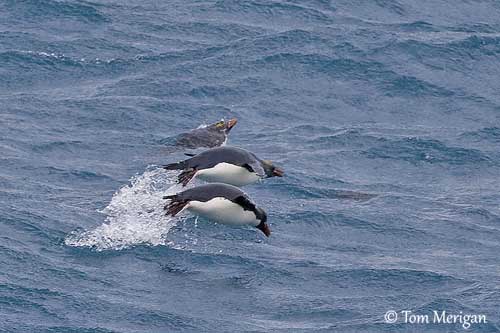
FLIGHT - MOVEMENTS:
Macaroni Penguin does not fly, but it swims very well! On the ground, it moves by hopping, thanks to the short, strong legs.
REPRODUCTION:
Macaroni Penguin arrives at colony between September and November. Eggs are laid between October and December.
The nest is a shallow scrape in mud or gravel, placed in shade under the vegetation, or sheltered by rocks and tussock grass.
Female lays 2 eggs. The first egg is grey and white, and small. Usually, this egg is rejected when the second is laid. The last is larger, blackish-grey, brown and white.
Incubation is shared by both sexes, and lasts about 35 to 40 days. Parents take turns, and incubate during 7 to 12 days each.
The male cares for the chick the first three weeks, usually during 23 to 27 days, and female brings food. The chick is covered with down, and at this time, it joins groups of chicks, named “crèches”, where they provide warmth and protection to each other.
The chick is still fed by its parents every 1 to 2 days, until it reaches its independence. It fledges at about two months of age, in February-March.
Macaroni Penguins leave the colony by April or May.
DIET:
Macaroni Penguin feeds mainly on krill, and also on squid (about 5%). It also takes some fish and crustaceans.
This species forages along the polar front, and may often travel up to 400 km to find feeding areas. Macaroni Penguin feeds mainly on crustaceans, but takes also some fish and cephalopods, mainly when feeding the chick. It hunts by pursuit-diving. During the day, it dives at 20 to 80 metres depth, but at night, only at 20 metres. It is able to remain under water during two or three minutes.
When swimming, the Macaroni Penguin uses its webbed feet for steering, while the tail is used as a rudder. It has very keen sight in the water.
